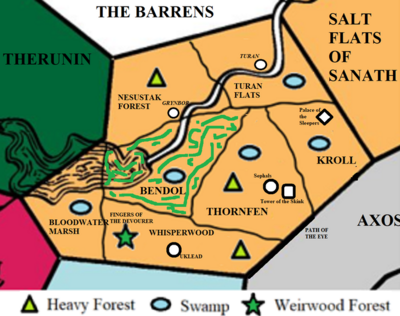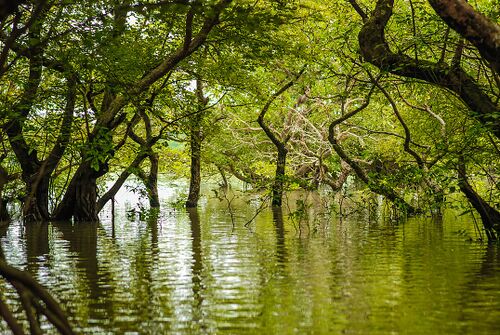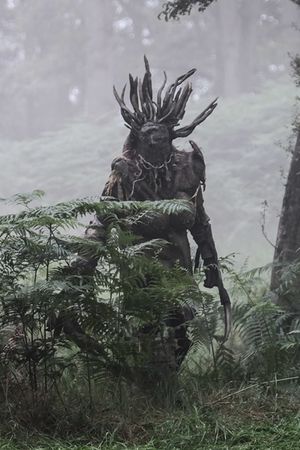Into Béantal Dol
The Mystery of Béantal Dol
During the Winter Solstice the Imperial Spymaster, Bernard Dugdale, made preparations for a foray into the Sarangrave specifically to infiltrate the vallorn of Béantal Dol. Sufficient weirwood was provided to establish an outpost on the eaves of the vallorn, but only for a season. Time was of the essence.
The stealthy approach used small boats from the Feverwater Docks. The eastern end of the lake is within Bendol, and within the bounds of the vallorn itself. Over the next three months, spies carefully infiltrated the cursed forest, taking every precaution to mitigate the venomous effects of the vallorn.
The Warding Stones
Around the circumference of Bendol are a series of sturdy stone monoliths. They're clearly very old, and marked with designs reminiscent of the curling patterns the Navarr favour, but more angular, scored deeply into the white granite pillars and in places inlaid with mithril. Some of the stones are embedded in the lake-bed, protruding a dozen feet or more above the surface of the water. The stones were different heights; it seems likely that they've all sunken into the muddy ground over the centuries since they were built to varying degrees but not impossible they were all the same size when they were created. Present on each stone examined was an arrangement of shaped pieces of ilium, five to each monolith, which an educated spy deduced represented the constellation known as the Chain – an astronomantic sigil used to empower warding magic of all kind. Each also bore a cruder, more makeshift design of curving, coiling points drilled into the stone – the Great Wyrm which represents profound transformation. This defacement appeared to have taken place at a later date and only about a third of the stones examined had this mark.
Some of the magicians among the scouting parties were able to examine these stones in more detail, although doing so exposed them to more danger of being spotted by the Druj. Their analysis is that they are permanent warding stones, such as might be employed with the Ward of the Black Waste or similar. Powerful Winter magic anchored by stones, and focused inward toward Béantal Dol.
A careful performance of Skein of Years, provided significantly more information. It seems the stones were built to take advantage of a grand conjunction of the Chain with the Web and the Wanderer. These stones were raised by the Terunael two-hundred-years or more before the vallorn was unleashed. They created an effective ward against marshwalkers – the destructive creatures found in swampy areas across the Empire and beyond. Marshwalkers are known to despise construction, attacking everything from dams to watchtowers or roads. It seems the wards kept the marshwalkers away while they built the city of Béantal Dol, and then protected the Terunael living there from their attentions.
The final sequence of visions revealed by the Skein of Years then jump ahead to the catastrophic collapse of Béantal Dol and the rise of the vallorn. Rather than flee, a coven of Night magicians supported by the power of an eternal used a desperate ritual to transform the protective magic of the stones focusing it inward, rather than outward. The vallorn's power was contained but not reduced; they form a bulwark against its terrible destructive power.
Within Bendol
The regions bordering Bendol show some mild signs of minor vallornspawn warping, but it is clearly no worse than that in Astolat or Reikos – a few strange flowers, some oddly-shaped fruit, aberrantly coloured berries. These are probably an artifact of times in the past where a little vallornspawn power has “lapped over” the warding stones in some fashion.
Bendol itself is a different matter. Is is a tangled, swampy forest familiar to those who have explored Therunin. In some places the vallorn miasma here is so thick that it hangs in the air like fog, obscuring sight and becoming difficult to breathe.
There are a lot of ruins here – it seems that the city was surrounded by several smaller settlements. The structures here are rarely more than two stories tall – its possible that the marshy ground was not ideal for anything larger. Trees grow close together, and it's sometimes easier to climb up into their branches and walk from trunk to trunk than it is to try and navigate the densely tangled undergrowth.
There's no real sign of any ettercaps, although there are a few sightings of the abominations so common in other vallornhearts. A common creature appears to be a long-tailed, long-muzzled person-sized lizard with six legs capable of camouflaging itself beneath the water whose jaws split in multiple directions revealing hundreds of hooked teeth as it erupts to devour prey. There are also serpentine creatures with dozens of spider-like legs that seem equally at home in the trees or in the river, who hunt by leaping at their prey and tearing them apart with their barbed claws before swallowing them whole.
But the real danger here is the husks. The place teems with them, both former-human and former-orc. Some clearly date back centuries, perhaps as far as the fall of Terunael. Many seem to be much more recent, with a few still wearing the remnants of the clothes or (in the case of orcs) armour they would have worn before succumbing to the miasma.
The husks are slow to react to the presence of the scouts but when a few are disturbed the sound of fighting rapidly attracts dozens of others, and then dozens more until the scouts are forced to retreat.
The Ruins of Béantal Dol
The Ruins of Béantal Dol itself lie along the river at the heart of the region, and likewise throng with husks. They are completely overgrown. What was clearly a grand harbour of some kind is completely choked with vegetation, thick enough that its possible to walk on without getting your feet wet. This is risky though. There are vallornspawn bound up within the thick carpet of vines, roots, and reeds that erupt up to grab at any who pass too close. There are also the odd lizard-things observed along the banks who slip through the tangled waters and burst through to savage scouts. Again the sound of fighting starts to attract more husks.
Béantal Dol is partially flooded – it looks as if the city once had artfully positioned levvies designed to keep the marshy waters surrounding it at bay. Obviously, once the vallorn took control these structures were quickly overwhelmed. This is again reminiscent of some of the ruins explored in Therunin. This may not be a coincidence – there are references to Tharunind and Béantal Dol being “twin cities” on either side of the Feverwater.
It's extremely difficult to do more than a quick survey of the city itself. Apart from the constant threat of vallornspawn, the air here is dank with miasma. There are patches where the air is so thick with the power of the vallorn that it is actually dangerous; on a couple of occasions an unfortunate scout stumbles into a cloud of fog-like miasma that chokes and throttles them, leaving them unable to breathe as their lungs fill with vines and brambles, transforming them rapidly into a vallornspawn husk. The best anyone can guess this actively poisonous mist is a consequence of the vallorn being contained. If the vallorn were unleashed its likely the miasma would rapidly spread out, becoming less hazardous as it did so.
The Grynbor
There is a likely explanation for why there are quite so many vallornspawn husks in Bendol. The Nesustak Forest lies north of Bendol. At the point where the river passes out of Bendol, there is a settlement made up of almost entirely humans with only a few orcs among their number. They are lead by a “monarch” appointed every nine years – currently a "Queen" Olwenna.
The Grynbor – they share their name with their settlement - are certainly subjects of the Druj but they're not slaves. They seem to have a certain amount of freedom, farming the forests near their homes for wood, ambergelt, and dragonbone. They also seem to “farm" the remains of Beantal Dol. Small expeditions press into the infested region, braving the miasma, in search of treasures and peculiar plants for their Druj overlords. They also operate flat-bottomed boats that carry lumber down the river, seemingly unconcerned about the threat of vallornspawn beasts from Bendol.
Some of the scouts are able to observe the notably grim practice reported by earlier spies. Whenever a Grynbor becomes sick, or too old to work, they are offered up to the vallorn of Bendol. A raft is filled with flowers and small gifts, and they either pole across the river themselves or are transported by a more abe-bodied pilot. When they reach Bendol, they gather armfuls of flowers and offerings and walk unarmed into the vallorn forest where they are quickly overwhelmed, becoming vallornspawn husks in their turn. There's no easy opportunity to make contact with the Grynbor – it's not clear that they would not immediately report any contact to the Druj.
The House of Bant Jarangir
Some of the spies explore further west and north than the others and they make a concerning discovery. While travelling through eastern Thornfen, the Navarr discover an encampment that seems a little out of the ordinary. Most of the structures in Thornfen are wattle-and-daub, but this camp is built around a cluster of stone buildings more in the style of those near the Tower of the Skink further to the south.
There are perhaps a hundred and fifty orcs here from the Marshlizard sept, busily protecting and serving a coven of perhaps a dozen orcs in green hooded robes all of whom wear leather masks. The reason they're notable to the scouts exploring Bendol is that they, too, seem to be paying an inordinate amount of attention to the warding stones around the forest.
A carefully executed ambush allows a group of scouts to capture some of the Druj near the camp. Once these guards are noticed as missing, an alarm is raised but the spies are able to get some information before making a clean getaway. With any luck the Druj will assume the guard patrol was slain by swamp beasts or perhaps vallornspawn.
This manor is the “House of Bant Jarangir”, and used to belong to a powerful and influential ghulai. They died some years ago, and the manor was claimed by a coven of magicians from the Palace of the Sleepers. A few years ago, during the height of the invasion of Urizen, this coven apparently came across a secret contained in one of the Urizeni libraries that caused a furore of interest at the Druj “college of magic.” The guards have no idea what it is, but before being executed they are able to confirm that these ghulai are fascinated by the vallorn. That's why this outpost at the “House of Bant Jarangir” has been established. They believe the buruk tepel of the Marshlizard Sept - Grahkunuz - is sponsoring the coven because they believe it will find a way to use the vallorn as a weapon against the Navarr of Brocéliande and Therunin, and perhaps even against the Empire.

Several of the vates accompanying the scouts have studied at the Great Library of Hacynian, and are making an assessment of what might happen if Beantal Dol were added to the trod network. They believe that the vallorn is equal in power to the Brocéliande vallorn, and that it would cause a great wash of Spring magic into the trod network – but as long as it was connected to the Barrens, Therunin, and Zenith the network could absorb that power without damage.
The warding stones are fascinating. It doesn't seem feasible to duplicate their properties – they're clearly the result of some ancient conjunction of constellations. Each is effectively an artifact that is part of a larger structure. Destroying them would require magic - likely the Words of Ending ritual. Breaking one or two would have little effect on the entire ward – its too durable and has persisted for too long to be that fragile.
But if enough were removed, especially if they were destroyed strategically, it would almost certainly weaken the ward sufficiently to allow the vallorn to begin expanding. It would start slowly at first, but their best estimate would be that the warding magic would unravel very quickly once it started to collapse. They predict the vallorn of Béantal Dol would explode outwards if the wards were entirely neutralised. The whole territory of Sarangrave would be consumed by the vallorn in a matter of months, half a year at the most, without needing any additional magic to encourage it to do so.
What this would mean for the grand plan is a little trickier to predict but it seems likely that if Béantal Dol were connected to the other vallorns, it would be equivalent in power to Brocéliande. If all the vallorns were connected together, it is unlikely that the existing wards would be sufficient to keep it contained.
Further Reading
Related Topics
- Advisor on the Vallorn
- Grey pilgrim
- Vallornspawn husk and Ettercap - Discussions of common vallorn creatures
- Trods and Trods, Roads, and Ox-carts - regarding trods
- The Dance of Navarr and Thorn - the ritual that creates trods
Vallornguard
- Vallornguard - the Imperial Sodality charged with spearheading the war against the vallorn
- Eight for a wish - 387YE Summer Wind of Fortune establishing powers and opportunities for the vallornguard
History
- Origins of the Vallorn
- Terunael in Axos
- Heirs of Terunael
- Drustan of the Briar
- Great Library of Hacynian
Winds of War and Fortune
- The war of thorns and flowers - 386YE Winter wind of fortune that includes details the opening of the war of thorns and flowers
- The Synod speaks - 386YE Autumn wind of fortune detailing League and Varushkan opportunities to support the Navarr against the vallorn
- The first shot - 386YE Autumn wind of fortune detailing the change to the stridings and the new armies
- The final countdown - 386YE Summer wind of fortune detailing the choice whether to begin the final war against the vallorn
- Into Béantal Dol - 386YE Spring report from an expedition to Bendol in Sarangrave
- A thousand years of longing - 385YE Winter wind of fortune about the findings of the Great Library of Hacynian
- Rain king - 385YE Spring Wind of Fortune detailing aid offered against the vallorn by the eternal Ossegrahn
- The bones of what you believe - 384YE Autumn Wind of Fortune detailing the opportunity to expand the Great Library at Hacynian
- One last song - 385YE Winter Wind of Fortune detailing the adventure into Brocéliande
- The city asleep - 384YE Autumn Wind of Fortune introducing the adventure into Brocélieande
- Whither the seed - 383YE Winter Wind of Fortune about the use of Wither the Seed on Brocéliande and Liathaven
- Rise of Terunael - 383YE Autumn Wind of Fortune regarding the plans of the Heirs of Terunael
- Comes a time - 383YE Summer Solstice wind of fortune relating to the future of Seren
- Blood for poppies - 382YE Summer Wind of War detailing the victory over the Liathaven vallorn
- Immolation - 382YE Spring Wind of War detailing the fight against the Liathaven vallorn
Click Expand to see a summary of the important pages related to the vallorn.

